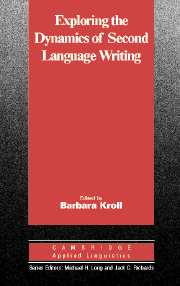Book contents
- Frontmatter
- Contents
- List of contributors
- Acknowledgments
- List of abbreviations used
- Series editors' preface
- Introduction: Teaching the next generation of second language writers
- I EXPLORING THE FIELD OF SECOND LANGUAGE WRITING
- II EXPLORING THE VOICES OF KEY STAKEHOLDERS:TEACHERS AND STUDENTS
- III EXPLORING WRITERS' FINISHED TEXTS
- IV EXPLORING CONTEXTUALITIES OF TEXTS
- V EXPLORING TECHNOLOGY
- EPILOGUE: EXPLORING OURSELVES
- Index
IV - EXPLORING CONTEXTUALITIES OF TEXTS
Published online by Cambridge University Press: 05 October 2012
- Frontmatter
- Contents
- List of contributors
- Acknowledgments
- List of abbreviations used
- Series editors' preface
- Introduction: Teaching the next generation of second language writers
- I EXPLORING THE FIELD OF SECOND LANGUAGE WRITING
- II EXPLORING THE VOICES OF KEY STAKEHOLDERS:TEACHERS AND STUDENTS
- III EXPLORING WRITERS' FINISHED TEXTS
- IV EXPLORING CONTEXTUALITIES OF TEXTS
- V EXPLORING TECHNOLOGY
- EPILOGUE: EXPLORING OURSELVES
- Index
Summary
As mentioned previously in this volume, writing courses are situated in specific places and contexts, accounting for some of the variation in how they are structured and what students are expected to learn or accomplish during their period of study. Having considered the voices of teachers and students in Part II of this volume and addressed issues surrounding student texts in Part III, we now, in Part IV, take up several additional factors that teachers and researchers must investigate in order to expand their understanding of what it means to teach second language writing.
Moving beyond an exploration of students, teachers, and texts, many writing theorists in both native language (L1) and second language (L2) studies call attention to the critical notion of “disciplinary communities,” recognizing that it is necessary to identify the ways writing is used to create knowledge in potentially different ways in different disciplines (see, for example, Berkenkotter & Huckin, 1995; Lea & Street, 1999; Prior, 1998; Swales, 1990). A key challenge for learners is that as they “move from one discipline to another … they are faced with the problem of reconciling differences and even contradictions associated with varying disciplinary practices” (Bhatia, 2002, p. 38). From this perspective, it becomes critical for writing teachers to understand genre, the topic of Chapter 8.
The extent to which discourse and rhetorical styles are culturally situated is another contextual factor that is specifically applicable in talking about L2 writing (as opposed to L1 writing).
- Type
- Chapter
- Information
- Exploring the Dynamics of Second Language Writing , pp. 191 - 194Publisher: Cambridge University PressPrint publication year: 2003

